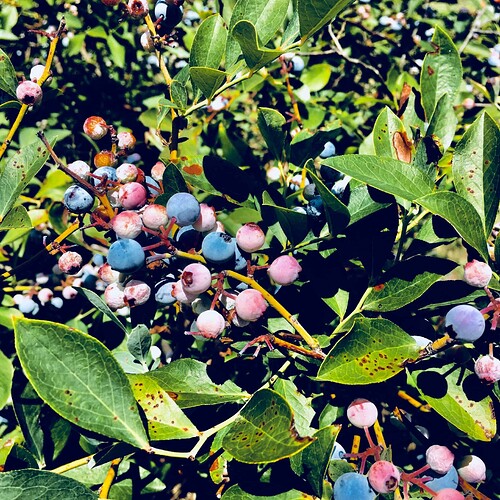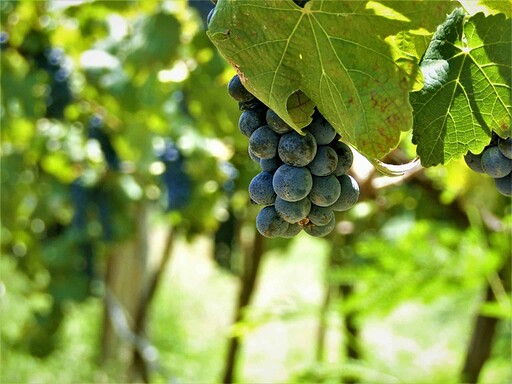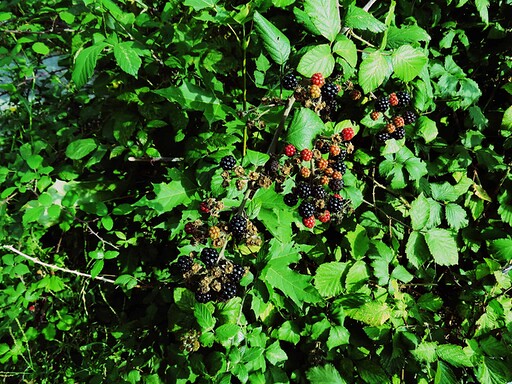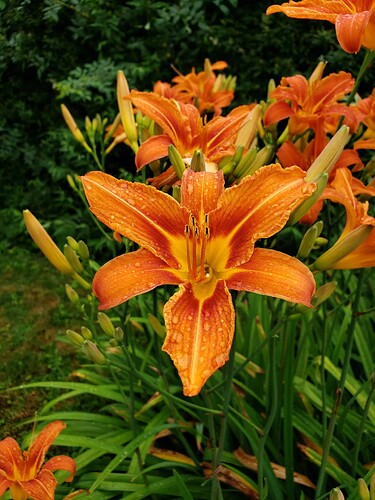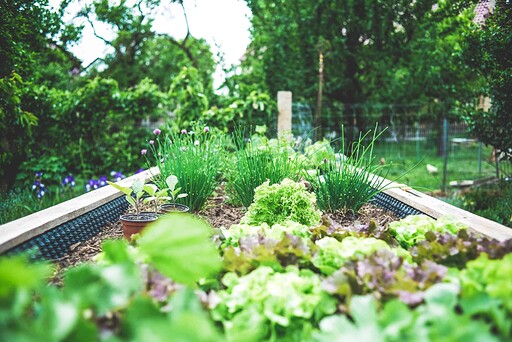Food production and beautiful landscaping don’t have to be at odds.
In fact, there are tons of options for complementing/replacing traditional ornamental lawns and landscaping with plants that will please both your eye, palate and stomach.
Of course, before starting, renters should make sure that changing any existing landscaping is ok with their landlord. Tilling up a yard or making any significant changes to the grass can cost money to undo if you move. If you are renting a house with some land attached, there is a good chance you can work out something with your landlord if you have a long enough lease.
You can also use containers or window boxes to grow food. These are not something that you have to get permission for, and they are a great option for those with patios and balconies. Containers also allow you to grow some things that have to be brought in when temperatures drop below freezing.
Garden Towers and other vertical gardens
You can grow a lot more food and create some attractive landscaping features by taking advantage of unused vertical space. Letting vines grow on concrete walls and house foundations is one popular way to do this that doesn't cost a lot. Sometimes you will need to add some type of grid. Wood is not recommended for the long term because it rots. I would advise avoiding any vines growing on your house at all if it is mostly wood. There is a danger of fire, too, if the vines dry out.Trellises, arbors, and cages all help provide a vertical framework for edible landscapes. If you like to do an art project once in a while, you could bend wires and create wire sculptures for plants to grow on.
Window boxes
Herbs and microgreens in window boxes will help cut your grocery bill. Edible flowers are another option.
Planters and containers on wheels
You can grow some big plants in containers, especially if you have them on dollies that you can move around wherever you want. This is helpful if you live in a place where temperatures dip below freezing. Plenty of people grow lemons, limes, and more in fairly cold places because they have the ability to bring plants inside or put them in a greenhouse when temperatures dip.
Hanging baskets
A hanging basket is beautiful when filled with cherry tomatoes or strawberries. These are a good choice for hanging off of porches or overhead on a balcony as long as plants can get enough light.
Blueberry Bushes
I love how easy blueberry bushes are to grow and how they can withstand a wide variety of climates. You can plant blueberries around your home for a pretty shrub that yields a lot of highly valuable fruit. Some blueberries will produce throughout a long growing season, whereas others will yield one large crop during a short harvest period. It can be nice for rural and urban homesteaders to have bushes that provide berries throughout the season. If you prefer to get one large crop and get all your preserving done in a short time, then choose short-season varieties. Some people find that having both types of blueberries is the best for them.
Blueberries can be grown in pots in many areas. A reader has told me in a colder climate that it doesn’t work well in extremely cold temperatures because the root ball freezes. If you live where it is very cold, you may want to provide some extra protection to your blueberry plants that are in containers during the winter months.
Dwarf and Semi-Dwarf Fruit Trees
Smaller fruit trees start to produce fruit earlier than standard trees, but they do not have as long a lifespan. The shorter height makes them much easier for the average person to harvest, and you can plant more trees per acre. You can plant dwarf apple trees a mere 10 ft apart, and their reduced height makes pruning and harvesting a lot easier. If you want a tree to provide a lot of shade to sit under, then a semi-dwarf may be a better option. Always check the expected size of any tree before you buy and plant. What constitutes a semi-dwarf, dwarf, or standard varies by fruit. For example, a standard plum reaches the same height as a semi-dwarf apple.Columnar Apple Trees
I like to mention these trees because they are great for borders and for growing in containers. Columnar trees only reach 18 inches wide but provide a lot of apples for their size. Instead of a non-productive privacy hedge, why not have one that looks prettier and provides bushels of fruit? For even more beauty and to experience a variety of apples, you could plant your columnar apple trees on a color scheme. For example, grow a green, red, and golden variety and then repeat the pattern until you fill your space.Grapes
A few grapes can be lovely and yield a lot of fruit. The key is to plant species that work well in your area. The wine grapes you are familiar with from the grocery store do not do well in cold or rainy climates. Cold hardy and disease-resistant grape varieties are widely available through mail order. You can grow grapes in climates that experience temperatures as low as -40 F.
You can use grapes to create a shaded arbor on your patio that is nice to enjoy on a hot day.
Brambles
- Blackberries
- Loganberries
- Marion Berries
- Raspberries
- Strawberries
Note: Black and Red Raspberries should not be planted within 75-100 feet of each other. Overall I cannot recommend planting Black Raspberries due to their susceptibility to viral diseases carried by aphids on other Raspberry varieties.
Top Vegetables For Edible Landscaping
While there are no firm rules about what you can plant, some vegetables work out well for a lot of aspiring edible landscapers. Here is a brief list to consider. Think of this list as something to build off of. What can you add to make your landscaping more colorful and delicious at the same time?Edible Flowers
Note: Make sure when purchasing plants and seeds that you are getting a flower that is edible. It can be easy to get confused with a similar name or blossom. If the scientific name is listed on a tag, it is easy to compare that to the scientific name you know to be edible.
- Day Lily
- Borage
- Marigold
- Nasturtium
- Pansy
- Squash Blossoms
- Parsley
- Rosemary
- Thyme
- Oregano
- Basil
- Lavender
<img class=“aligncenter wp-image-614198 size-large” src=“https://peakprosperity.com/wp-content/uploads/2021/10/viktor-forgacs-jKlzW7riLcU-unsplash-scaled.jpg” alt="“peppers” width=“512” height=“389” />
Planting different colors of peppers can create a bright and cheerful display around the outside of your home. Mixing sweet and hot peppers into your landscape gives various shapes and a wide range of contrasting colors. Be careful, and don’t go overboard planting hot peppers. A few plants will grow as many hot peppers as you want, even if you like to eat a lot of spicy food.
Alliums
- Bunch Onions
- Egyptian Walking Onions
- Garlic
- Red, white, or yellow bulb onions
- Chives (This little herb loves to spread. You will have to take steps to control it, such as giving it a tiny little bed with a divider or just growing it in a pot.)
<img class=“aligncenter wp-image-614197 size-large” src=“https://peakprosperity.com/wp-content/uploads/2021/10/eric-prouzet-S3TXx97fhkA-unsplash-scaled.jpg” alt="“beans” width=“512” height=“340” />
Pole beans make good use of vertical space, have pretty flowers, and then you can enjoy the color and beauty of the maturing bean pods. While green may be the color that you think of when you hear the word bean, the truth is that there are beans in a lot of different colors and patterns. Just take a look at any seed catalog with a good selection, and you will likely find a few colorful varieties suitable for your climate and growing season.
- Artichokes
- Kale
- Rhubarb
- Chard
- I recommend Rainbow Chard because it tastes great, is highly nutritious, and you get items that are yellow, purple, red, pink, and green.
Seasonally Rotated Gardens
Planning out when you plant what is essential to producing a continuous abundance of vegetables is smart. This schedule will be dependent on your region. It is a good idea to get an early start on Spring gardens so you can get as much out of your entire growing season as possible.Raised Beds
Raised bed gardening is popular for many reasons. You can establish a raised bed without tilling, for starters, if you bring in your soil and other amendments. You can also use chickens in a chicken tractor to build up beds to a high fertility level. Raised beds allow people to grow gardens where the actual soil may be too poor to produce enough.
The sides of raised beds can be made of wood, concrete, or rock. Cypress is a good rot-resistant board to use if you can find it. There is some debate over the use of treated lumber for garden beds. In the past, treated lumber was created with arsenic, but now copper is used. I think you should definitely avoid using any lumber scavenged from older homes with any paint or other treatments. Up until the late 1970s, lead-based paints were being used.
Small To Medium Sized Greenhouses
While greenhouses are not landscaping, they can become an excellent addition to the overall landscape and provide you with a private refuge during the dark and cold months of the year.There are so many small greenhouse kits available. I have to say that some take days to put together, and it helps to have someone to assist you when you put them together. Different thicknesses of panels are out there, so it is essential to make sure you are getting a greenhouse that is suitable for your climate. Plenty of DIY types have constructed greenhouses out of reclaimed windows and glass panels. Remember that glass that is not tempered is prone to breakage and will break into shards if hit hard enough. Glass greenhouse that is not made from reclaimed materials are typically made with tempered glass. You could use window security film to prevent the glass from breaking into shards. I could see this being a reasonable option if you have a lot of recycled materials to use because you would save a lot of money overall.
Transitioning From Yard To Edible Landscaping
If a lot of chemicals have been used in your yard in the past, you may want to give it some time before you grow anything. A month of not using anything is advisable if a lot of chemicals were used.Yards with lots of grass will need to be plowed or tilled and cultivated well. Be prepared for grass to come up often when first establishing your garden beds and edible landscaping. Mulch can help with this if you want to add organic matter and do not have the time to weed as often as needed at the beginning of your edible landscaping adventure.
What are you allowed to do?
If you live in a planned community or anywhere that has an HOA (Homeowner's Association), there may be some rules regarding what is allowed in your yard. At the same time, you may not have worried that much about what you signed when you moved in; you could be in for a big surprise when it comes to making significant changes around your home. Some areas may not allow a lot of gardening projects. That is not to say that rules cannot be changed if most people agree or that exceptions are not made. Fencing around gardens, mulch and compost piles, etc., may also be regulated.Planning Out Your Space
Sketching out or using a computer program and aerial shot of your property can be good ways to plan your edible landscaping projects in great detail before embarking on them. Then again, you can just start planning out a small space at a time. Creating a blueprint for your whole space is most helpful if you care about the overall theme and look a lot and want to get things just so.Rooftop Gardens and Landscaping
There are some beautiful examples of rooftop gardens in cities. Sometimes this can be a great project for multiple families in a building to enjoy. If you have a building to yourself that has a flat roof then you need to do some calculating and planning before creating a landscape up there. A roof is only designed to hold so much weight. You do not want to find yourself in the position of overloading your roof. A building inspector may be able to help you figure out what is safe to do. Some flat roofs are not made to be walked on regularly so you will need to consider that.Your edible landscaping will attract wildlife.
Even if you are not near any major forests or wildland, there is a decent chance you will have some trouble with animals trying to eat your garden.- Groundhogs or Wood Chucks
- Deer
- Mice and Rats
- Rabbits
- Raccoon
- Opossums
- Skunks
- Squirrels
- Birds
Air rifles and pistols are a lethal option that doesn’t make a noise like a bullet. Fences can help prevent some intrusion, especially if you have a dog that patrols within the fence. It can take some time to train your dog to stay out of the garden and landscaped areas, but it is well worth it. Even our ten-month-old German Shepherd has learned that some areas are off-limits. He doesn’t dig in them or lay in them.
Compost piles can be particularly attractive to animals. Rotting and composting food attracts mice and rats. If you have a cat, they can help reduce any damages. I will warn you that some people have a problem with cats that are allowed outside to roam their yards and hunt, especially if they see your cat catch a squirrel or bird. I think cat’s fill an important niche. If they didn’t hunt the smaller wildlife, another predator would move in to fill the gap. That is how nature tends to work, like it or not.
Edible Landscaping Books
Here are a few popular books on edible landscaping and raised bed gardens.Gaia’s Garden: A Guide To Home-Scale Permaculture by Toby Hemenway
Conclusion
Edible landscaping is a great option for those that are tired of maintaining a lawn that doesn't offer them a lot. Edible landscaping is beautiful and it can add to the curb appeal and value of your home. Using edible plants for landscaping is not just for those that own their house. Containers, small removable greenhouses, and seasonal garden beds are realistic options for renters that have lenient landlords.Have you converted your yard to gardens and edible landscapes? What do you recommend for dealing with unwelcome wildlife?
This is a companion discussion topic for the original entry at https://peakprosperity.com/edible-landscaping/
